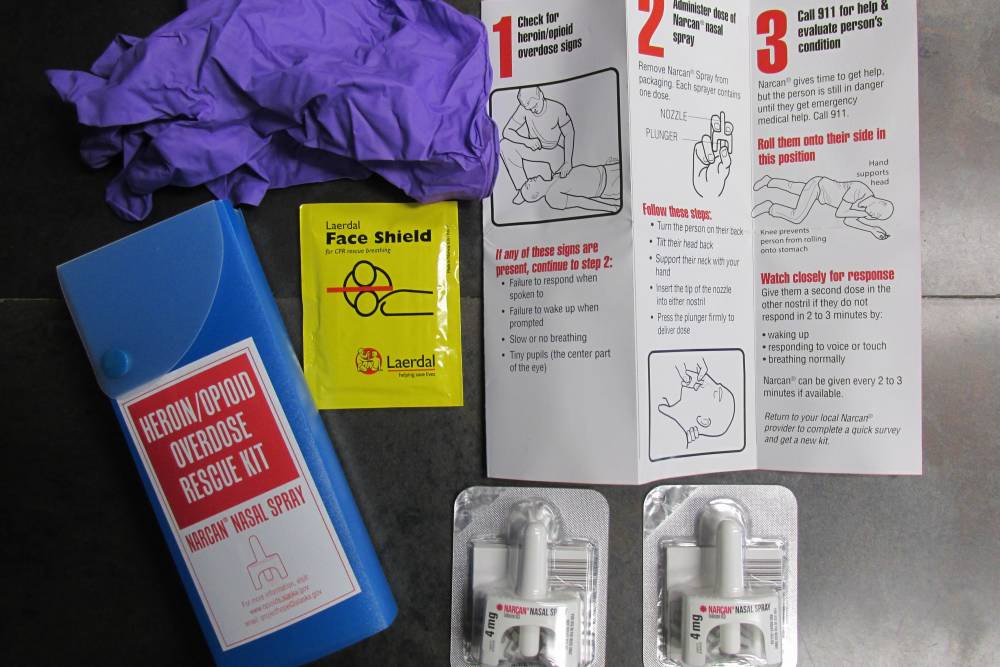
Would you know what to do if someone experienced an opioid overdose? Following a Ketchikan Chamber of Commerce luncheon, with construction activity going on outside, public health nurse Lindsey Lamon held a training session and distributed emergency kits that could save a life.
Opioids are medications derived or synthetically made from the opium poppy plant that block pain signals to the brain. As people build tolerance, they need more of the drug to relieve pain. This can lead to dependence and addiction.
Lamon discussed the effects of opioids. She says centers in the spinal cord and brain store opioids. If they receive too much opioid on them, it will cause a person to stop breathing.
“If you stop breathing you don’t have any oxygen available for your brain. Your brain needs a lot of oxygen, so your brain ultimately will shut down as well.”
Narcan is the brand name for the drug naloxone, a medication that reverses an opioid overdose.
“What Narcan does is, once it gets into the body, those receptors in the body want to hold the Narcan more than they want to hold the opioid. So when that Narcan comes in, it pretty much kicks the opioid off those receptors and the Narcan takes its place.”
Once it kicks in, Lamon says the person starts breathing again. She says it acts quickly, usually taking about 30 to 45 seconds. She says Narcan does not have any ill side effects if you give it to someone who doesn’t need it.
“If you find someone who is passed out who is exhibiting the signs of an overdose and you give them the Narcan, and they’re there because they have overdosed on some other drug or they’ve had a heart attack or they’ve had a stroke and you give them the Narcan, it is not going to have bad side effects that will exacerbate the problem that’s already caused this.”
Some of the signs of an opioid overdose include small pupils, shallow breathing or respiratory failure, unresponsiveness and blue skin color.
Lamon says if you suspect someone has overdosed, you should first call 9-1-1 before administering Narcan. She says if there is a high level of opioids in the system, Narcan is only effective for about 30 minutes. It is also possible it may not work. Lamon says it’s important that a person gets medical help or they could overdose again when the Narcan wears off.
Before administering Narcan, Lamon says the person should be placed on their back with the head tilted up. Narcan is distributed through a nasal spray.
“It’s just in a little canister. There’s no lid that you have to take off. There’s just a little pin point hole. You just insert it into the nostril and you just push, right here on the bottom.”
Immediately after administering Narcan, Lamon says the person should be put in the “recovery position” by rolling them on their side and bending the top knee for support. She says it’s important to then back away from the person because they will immediately go into withdrawals.
“It is not a pretty sight. A lot of people will wake up and they’ll be fighting. A lot of people will wake up and they’ll start vomiting. They may have some diarrhea. They’re going to be very anxious. They’re going to probably be in a lot of pain. So don’t expect a ‘thank you’ pat on the back.”
There are two doses in each kit. Lamon says a dose can be given every two to three minutes. She says this might be necessary because they didn’t respond the first time or they have a high amount of opioids in their system and experience a second overdose when the Narcan wears off.
During an earlier presentation, representatives from the Ketchikan Wellness Coalition noted that one in 20 people nationwide uses opioids. Though not all are addicted, some are, and the signs may not be obvious. Lamon recommends every business have a Narcan kit. It’s also recommended to have a kit at home. While Narcan won’t stop an addiction, it can save a life.
Free Narcan kits are available from most medical providers, at the Public Health Center and The Safety Specialists.





